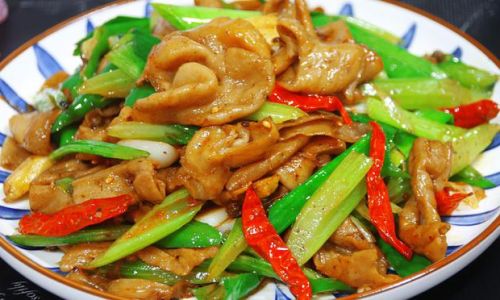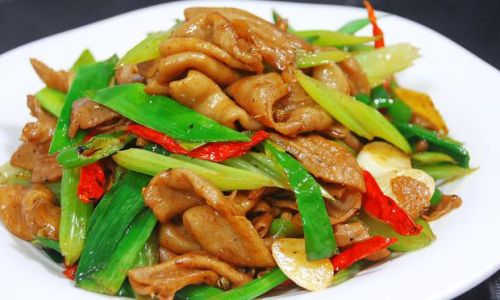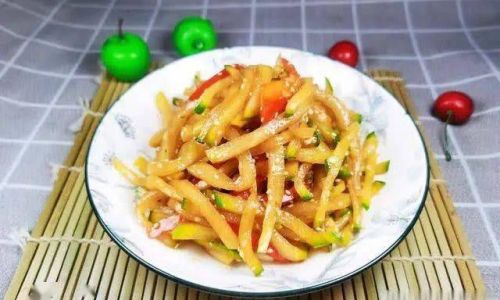Stir-fried pork intestines, known as baǒchǎo féicháng in Chinese, is a dish that tantalizes the senses with its crispy texture, bold flavors, and aromatic complexity. Revered in Chinese cuisine for its ability to transform humble ingredients into a culinary masterpiece, this dish requires precision, patience, and a deep understanding of flavor balancing. Whether you’re a seasoned home cook or a curious food enthusiast, this guide will walk you through every step of creating restaurant-quality stir-fried pork intestines, from cleaning and marinating to achieving that coveted caramelized char.
The Allure of Stir-Fried Pork Intestines
Pork intestines, often overlooked in Western kitchens, hold a cherished place in Chinese gastronomy. When prepared correctly, they offer a unique interplay of chewiness and crispiness, with a rich, savory taste that pairs beautifully with spices and vegetables. The dish’s appeal lies in its contrasts—the tender yet slightly resilient texture of the intestines, the fiery kick of chili peppers, the earthy warmth of garlic and ginger, and the umami depth of fermented sauces. It is a celebration of wok hei, the breath of the wok, that smoky essence imparted by high-heat stir-frying.

Ingredients: Building Flavor Layer by Layer
To recreate this dish authentically, gather the following ingredients:
For the Pork Intestines:
- 5 lbs fresh pork intestines (preferably the thick, meaty colon section)
- 2 tbsp coarse salt
- ½ cup white vinegar
- ¼ cup all-purpose flour
- 1 tbsp baking soda (optional, for tenderizing)
For the Marinade:
- 2 tbsp light soy sauce
- 1 tbsp Shaoxing rice wine
- 1 tsp sesame oil
- 1 tsp white pepper
- 1 tsp cornstarch
For the Stir-Fry:
- 3 tbsp cooking oil (peanut or vegetable oil preferred)
- 6 garlic cloves, minced
- 2 tbsp fresh ginger, julienned
- 3-4 dried red chilies (or 1 tbsp chili flakes, adjust to taste)
- 1 medium onion, sliced
- 1 bell pepper (any color), thinly sliced
- 2 scallions, chopped (white and green parts separated)
- 1 tbsp fermented black beans (douchi), rinsed and minced
- 1 tbsp doubanjiang (spicy bean paste)
- 1 tbsp oyster sauce
- 1 tsp sugar
- 1 tsp dark soy sauce (for color)
- ½ cup chicken broth (or water)
- 1 tbsp cornstarch dissolved in 2 tbsp water (for slurry)
Optional Garnishes:
- Fresh cilantro leaves
- Toasted sesame seeds
- Sliced Thai bird’s eye chilies
The Preparation: Cleaning and Tenderizing
The success of this dish hinges on meticulous preparation. Pork intestines require thorough cleaning to remove any impurities and odors.
-
Cleaning the Intestines:
- Rinse the intestines under cold water, using your fingers to gently dislodge any debris.
- Place them in a large bowl and rub vigorously with coarse salt and vinegar for 5-7 minutes. This step neutralizes odors and softens the tissue.
- Rinse again, then coat with flour. The flour absorbs residual slime and impurities. Scrub for another 3-4 minutes, then rinse until the water runs clear.
- For added tenderness, soak the cleaned intestines in a baking soda solution (1 tsp baking soda per 4 cups water) for 30 minutes. Rinse thoroughly afterward.
-
Boiling and Cutting:
- Place the intestines in a pot of cold water with a few slices of ginger and a splash of rice wine. Bring to a boil, then reduce heat and simmer for 45-60 minutes until tender but not mushy.
- Drain and let cool. Slice diagonally into ½-inch thick pieces. The diagonal cut maximizes surface area for crisping.
-
Marinating:
Toss the sliced intestines with the marinade ingredients. Let sit for 20-30 minutes to allow the flavors to penetrate.
The Stir-Fry: Mastering Wok Technique
Stir-frying at high heat is non-negotiable for achieving the dish’s signature texture and flavor. Follow these steps closely:
-
Preheat the Wok:
Heat your wok over high heat until it begins to smoke. Add 2 tbsp oil and swirl to coat. This prevents sticking and ensures even cooking.
-
Sear the Intestines:
Add the marinated intestines in a single layer (work in batches if needed). Let them sear undisturbed for 2-3 minutes until golden-brown. Flip and repeat. This step is crucial for crisping the exterior while keeping the interior tender.
-
Sauté Aromatics:

Push the intestines to one side of the wok. Add the remaining 1 tbsp oil, then toss in the garlic, ginger, dried chilies, and fermented black beans. Stir-fry for 30 seconds until fragrant.
-
Build the Sauce:
Add the doubanjiang, oyster sauce, sugar, and dark soy sauce. Stir quickly to combine. Deglaze the wok with chicken broth, scraping up any browned bits (these add depth).
-
Incorporate Vegetables:
Add the onions, bell peppers, and white parts of the scallions. Stir-fry for 2-3 minutes until slightly softened but still crunchy.
-
Thicken and Finish:
- Pour in the cornstarch slurry while stirring continuously. Cook for 1-2 minutes until the sauce coats the ingredients in a glossy sheen.
- Fold in the green scallion parts and remove from heat immediately to prevent overcooking.
Serving Suggestions: Balancing Richness
Stir-fried pork intestines are best enjoyed piping hot, paired with steamed jasmine rice or thin egg noodles to soak up the flavorful sauce. For a balanced meal, serve alongside:
- Stir-Fried Bok Choy: A crisp, lightly seasoned green vegetable cuts through the dish’s richness.
- Tomato Egg Drop Soup: The tangy broth provides a refreshing contrast.
- Pickled Vegetables: Quick-pickled cucumbers or daikon add a bright, acidic note.
Pro Tips for Perfection
- Control the Heat: Maintain high heat throughout cooking to ensure caramelization without steaming the ingredients.
- Avoid Overcrowding: Cook in batches if necessary to prevent the wok from cooling down, which leads to stewing instead of stir-frying.
- Adjust Spice Levels: Tailor the chili quantity to your preference. For a milder version, omit dried chilies and use sweet paprika instead.
- Texture Tweaks: For extra crispiness, double-fry the intestines: sear once, remove, then fry again in hot oil for 1-2 minutes before stir-frying.
Regional Variations: Exploring China’s Culinary Diversity
- Sichuan Style: Amplify the heat with Sichuan peppercorns and doubanjiang, and add julienned celery for freshness.
- Cantonese Approach: Use a lighter sauce with oyster sauce and Shaoxing wine, paired with sliced water chestnuts for crunch.
- Taiwanese Twist: Incorporate basil leaves and a splash of rice vinegar for a bright, herbal finish.
Health Considerations and Myths
While pork intestines are high in cholesterol, they also offer protein, collagen (beneficial for joint health), and B vitamins. Moderation is key—pair the dish with fiber-rich vegetables and limit consumption to occasional indulgence. For a lower-fat version, skip the marinade’s sesame oil and use leaner cuts of intestine.
Troubleshooting Common Issues
- Chewy Texture: Overcooking during boiling or under-searing. Ensure intestines are tender but not falling apart after simmering, and sear until crisp.
- Bitter Aftertaste: Inadequate cleaning. Rinse thoroughly with vinegar and salt.
- Soggy Sauce: Overcooking vegetables or using too much cornstarch slurry. Add slurry gradually until desired thickness is achieved.
The Cultural Significance of Offal Cuisine
In Chinese culinary tradition, offal dishes like stir-fried intestines reflect a philosophy of bu tiao bu qi—using every part of the animal respectfully. These dishes, once peasant food, have gained gourmet status, symbolizing resourcefulness and culinary artistry. They are often served at banquets as a testament to the chef’s skill.
Conclusion: A Journey Worth Savoring
Mastering stir-fried pork intestines is a labor of love, but the results—a symphony of textures and flavors—are deeply rewarding. This dish is more than a meal; it’s a bridge to centuries of culinary heritage, a testament to the magic of transforming humble ingredients into something extraordinary. Whether you’re cooking for a crowd or treating yourself, let this guide empower you to wield your wok with confidence. After all, the best dishes are those made with patience, passion, and a pinch of adventure.
Now, light your stove, heat your wok, and let the sizzle begin. Your taste buds—and your dinner guests—will thank you.






0 comments